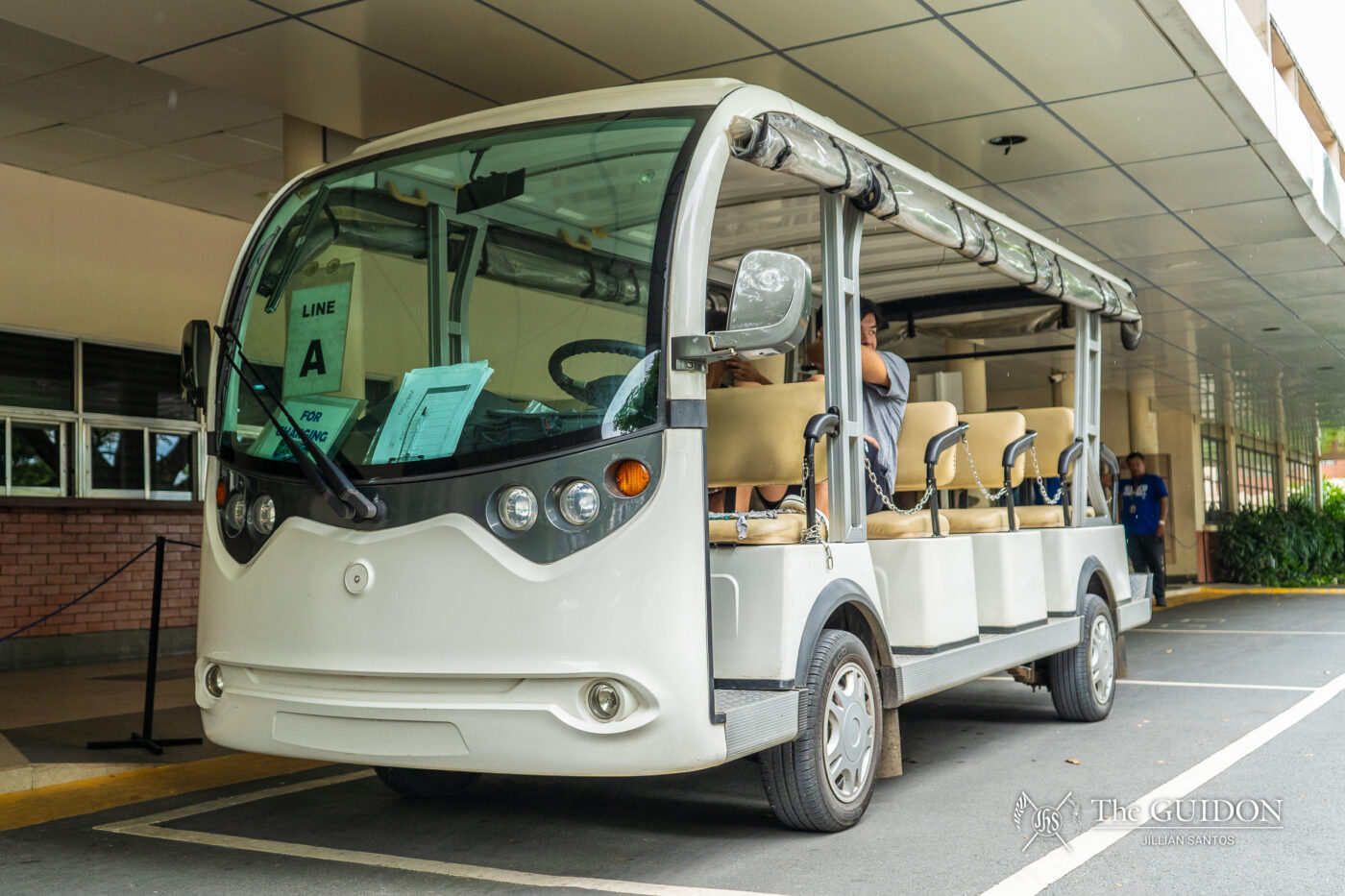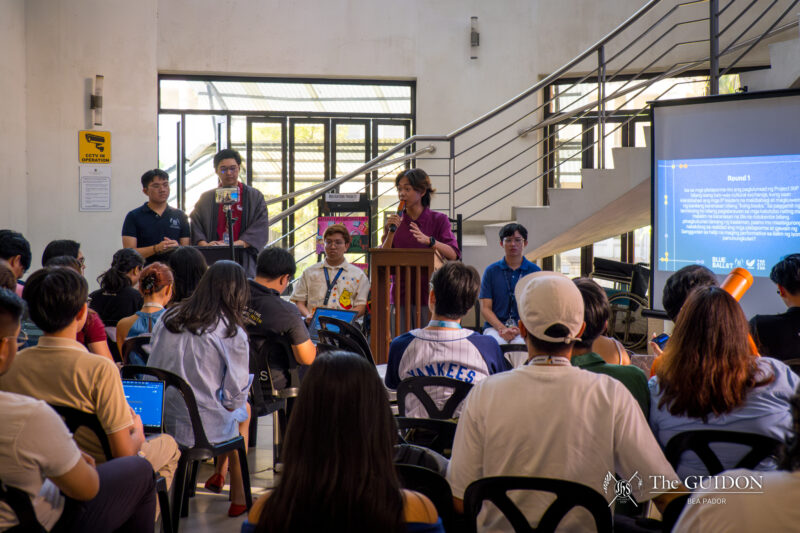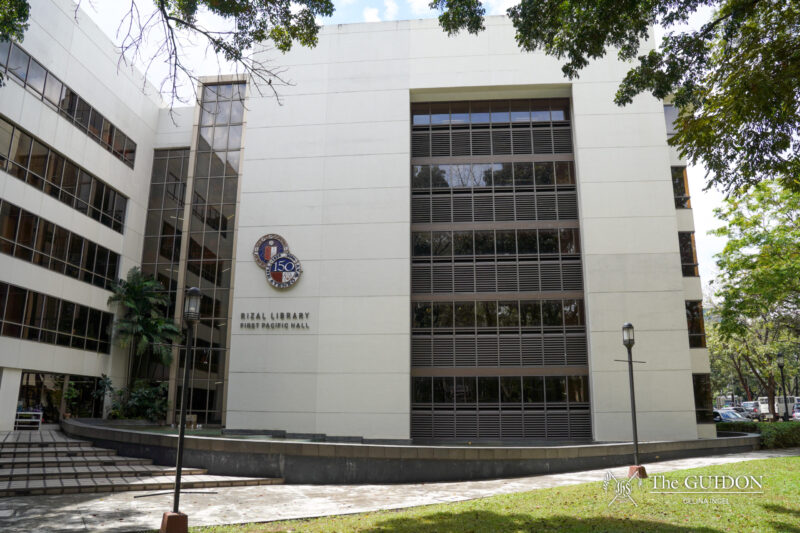NEW E-JEEP routes are slated to open this academic year, introducing express lanes along the School of Management (SOM) Forest, Red Brick Road, and the North Carpark.
Vice President for Administration Rodolfo Ang announced this development during a roundtable discussion with the Sanggunian and the Council of Organizations of the Ateneo – Manila (COA-M) last September 18.
The meeting was also attended by Assistant Vice President for Ignatian Leadership Formation Marie Joy Salita, PhD, Assistant to the Vice President for Administration Jaime Ignacio, Associate Dean for Student Affairs Rene Salvador San Andres, MA, and Director for Campus Life Chris Castillo, MA.
According to Ang, this rerouting scheme was undertaken to provide a more convenient alternative means of transportation within the campus by shortening the travel time of e-jeeps. He explained that making dedicated express lanes is necessary as the e-jeeps’ efficiency is currently limited by other vehicles under their current route.
Rerouting e-jeeps
During the meeting, Ang disclosed that alongside the creation of the new express lanes, the administration also plans to increase the number of e-jeep fleets on campus and move e-jeep stops closer to pedestrian gates. Following this, the E-Jeep Line A Grade School stop was relocated near Gate 1 from its previous terminal near Henry Irwin Lee Theatre.
Moreover, Ang shared that express lanes will be applicable for both Line A and Line B to provide e-jeeps with shortcuts to avoid traffic “choke points” inside the campus.
Line A will see new stops for its express lane, as it will skip the West Diversion Road and Leong Hall to go through the SOM Forest and Red Brick Road instead. The new Line A express lane will also include stops at Gate 1, JSEC, Old Rizal Library, Xavier Hall, Cervini Hall, Old Communications Building, and the Loyola House of Studies.
While previously mentioned to be one of the new stops for Line A during the meeting, the MVP Building is not included in the new route map provided by the administration to The GUIDON.
Meanwhile, the Line B express lane will skip Xavier Hall to instead pass through Areté, Bellarmine Hall, Junior High School (JHS) Inner Driveway, the Formation and Learning Center (FLC), and the Social Developmental Complex (SDC). Similarly, changes will also be expected for the Line B regular lane as it will now stop at Areté, Xavier Hall, Cervini Hall, JHS Inner Driveway, FLC, and SDC.
To proceed with the construction of the new lanes, Ang revealed during the meeting that 17 cm mahogany saplings and 30 cm talisay saplings will be removed. He added that it is the University’s direction to take down all mahogany trees on campus due to their invasive nature.
After the meeting, however, Ignacio clarified that from four, two mahogany trees will be felled along the route of the new e-jeep express lanes. Additionally, three native species—one campanilla, one salisi, and one talisay tree—will also be balled out.
Ignacio explained that the Campus Grounds Advisory Committee (CGAC) is currently reviewing the administration’s plans to replant the native trees on other parts of the campus.
According to Ang, the administration has secured the approval of the Ateneo Institute of Sustainability (AIS) and the CGAC for the construction of the express lanes.
Ang added that the project has already been awarded to a contractor and will follow a two-month completion timeline. As such, he clarified that the construction of e-jeep lanes is no longer being considered for endorsement “because it has [already] been endorsed by the student leaders last year.”
“When we presented [the project] to the faculty and the students, no one objected. Everyone said [that] it was a good idea,” Ang remarked.
However, upon clarification with COA-M President Kayla Manlapaz—who was present during the initial consultation with Ang last March 14—there was “no explicit ask for [an] endorsement.” Instead, she said the meeting served as an avenue to discuss the e-jeep improvements and gather suggestions from the attendees.
Rising concerns
With Line A’s express lane passing through Red Brick Road, School of Social Sciences Representative Mari Macasaet raised concerns about pedestrian safety, questioning if the administration has plans to improve and maintain the road.
Ang responded by explaining that paver blocks will be used for the express lanes, as e-jeeps are lighter in weight compared to private vehicles. He added that removable bollards will also be installed to indicate the boundary between the express lane and the walking path for pedestrians.
Ang clarified that the e-jeeps will adjust accordingly and reroute back to the original lanes when events are being held in Red Brick Road. With this, he requested relevant offices to craft guidelines on the use of the Red Brick Road once e-jeeps start to operate via the express lane.
As of writing, the administration has no plans to hold formal consultations after the September meeting. However, Salita suggested for these consultations to be held by the Sanggunian through conversations with student groups.
Meanwhile, Ang stated that the University will only release an official announcement once the new express lanes are ready for implementation.
Constructing changes
Besides e-jeep express lanes, the meeting also discussed the progress of other renovation and construction projects on campus. One of the major projects currently underway is the Blue Eagle Gym’s (BEG) renovation, which is expected to be completed by December 2024, as confirmed by Ang during the Magtanong sa VP at mga Dekano last October 4.
During the meeting between the administration and student leaders, Ang revealed that the administration is looking to open BEG with a “big launch activity” in January 2025.
Upon BEG’s completion, all athletics activities, such as the Table Tennis training currently held at Gonzaga Hall, will return to their original training venue. Notably, the Commencement Exercises for the Class of 2025 will also be held at the newly renovated gym.
Meanwhile, Ang noted that the construction for the planned five-story Matteo Ricci Hall is now in its design phase. For this project, he said that the administration would announce the start of construction since it would require a temporary closure of the first and second floors of the building.
On another note, Ang also mentioned that the upcoming dining hall in the New Rizal Library will comprise two sections—an al fresco canteen outside the library and an air-conditioned space inside. Old Rizal Library will also be undergoing renovation, with plans to convert it into a research facility for the Higher Education community.
When asked about how the aforementioned plans are accounted for in students’ tuition fees, Ang disclosed that budgets for major projects do not come from tuition fees. Instead, he shared that they come from private donations and fundraising efforts, citing the BEG “Name A Seat” initiative as an example.
However, Ang also noted that operational expenses—such as small renovations, utility costs, and additional janitorial services—are sourced from the tuition.
With multiple construction projects slated to ensue in the following months, Ang stated that releasing memos is not necessary unless a certain project will largely disrupt the normal activities of the Ateneo community. However, he said that he is also evaluating which updates need to be mentioned to the student body.
Editor’s Note: After the article’s release, the administration informed The GUIDON that the number of mahogany trees to be felled has been decreased from four to two since the clarification with Assistant to the Vice President for Administration Jaime Ignacio last October 4. The article has been updated to reflect this change.







